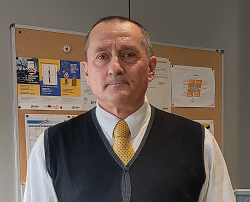Since its inception, Hera has had “Health and Safety in the workplace” among its founding principles. For this reason, over time it has defined specific strategies and implemented improvement plans that proved to be effective, as shown by the positive performance recorded over the years.
Especially in 2021, Hera achieved a significant decrease both in the frequency of accidents and in the number of days the employees were absent from work, reaching the best results in its history.
Despite the levels of excellence already reached, Hera aims to achieve further improvements, through the dissemination of a safety leadership and an intensive training, which will increase people’s awareness and make safety culture endemic. The tools provided by technological innovation will also play a part in facilitating this process.
We discuss these issues by asking a few questions to Claudio Coltelli, Head of Health, Safety and Emergency Services at Hera Group.
What were the results for 2021?
In 2021, the Group recorded the lowest number of accidents and hours of absence ever. Compared to 2019, the last year of regular operations, unaffected by the pandemic, we achieved a reduction around 27% and 38%, respectively. These performances confirm our trend of constant improvement over the last few years.
This is a truly remarkable result, which is also against the national trend. In Italy, the frequency of accidents in 2021 increased by 0.2%, according to the data issued by INAIL, the National Institute for Insurance against Accidents at Work.
How do you explain these results in opposite direction to the average for the Italian companies?
The work in terms of training, culture and awareness that we carried out in recent years on the Group’s people, from workers to executives, certainly had a positive impact. Another important factor is the ERM approach, which involves identifying risk scenarios that might impact the Group, with financial and reputational consequences, applied in the area of “Health and Safety”. Moreover, the conditions of the pandemic context likely led people to an increased “state of alert”. The challenge now is to consolidate these results and improve them further over time.
The lower the number of hours of absence, the higher the number of hours worked. How does this correlation translate into economic and social terms?
The improvements achieved in 2021 are an excellent result, which, in addition to bringing substantial benefits in social terms and greater well-being to workers, also had a major impact on the Group’s productivity and consequently on operating costs, in terms of both direct and indirect costs.
Spreading the “Culture of Safety” in such a proficient way also means involving stakeholders. How does Hera manage to enhance this approach along its value chain?
We start from a structured process of training of internal resources in order to raise the awareness of external stakeholders, especially suppliers. One of the initiatives that the Hera Group has already pursued for several years is the monitoring of accidents and “near misses” of its suppliers of both works and services, through a detailed and digitalised reporting. This monitoring is useful not only for operational control activities but also to stimulate the supply chain to further improve its own performance in “Health and Safety”.
Training hours in Quality, Safety and Environment increased by 30% compared to 2019, with a significant concentration of activities and investments. What initiatives have you integrated recently?
In addition to the Health and Safety training activities for the whole staff, in order to further impact the safety leadership process, in 2021 we activated a specific path for all 350 Group executives, which subsequently led to a mentoring activity focused on a few dozen of them. Given the excellent feedback in terms of role awareness and safety leadership, the mentoring initiatives are continuing in 2022. At the same time, we are designing new digital multimedia training formats for the entire company, which will be available both on the training portal and as part of Heracademy activities.
One of Hera’s health and safety objectives is further reduction in the accident frequency index, with the aim to reach a level of 10.2 points by 2025. What actions will you put in place to achieve this goal?
Technological innovation will help us with innovative solutions that will make processes more efficient and effective. Therefore, we are already working on a safety app to support workers who work alone with the aim to report emergency situations, on the digitalisation of employees’ health records for more efficient and effective health surveillance, and, last but not least, on the development of SAP EHS DPI, an IT tool for the management of personal protective equipment and work clothes.
In terms of the working environment, we aim to ensure that safety standards are maintained through continuous investment in monitoring, maintenance, and adaptation to the best available technical solutions. Concerning the human factor, we will enhance training activities on safety procedures; moreover, we will work to improve awareness of the risks associated with individual roles and the importance of respecting the rules, as we believe that this will trigger a positive viral contamination.















